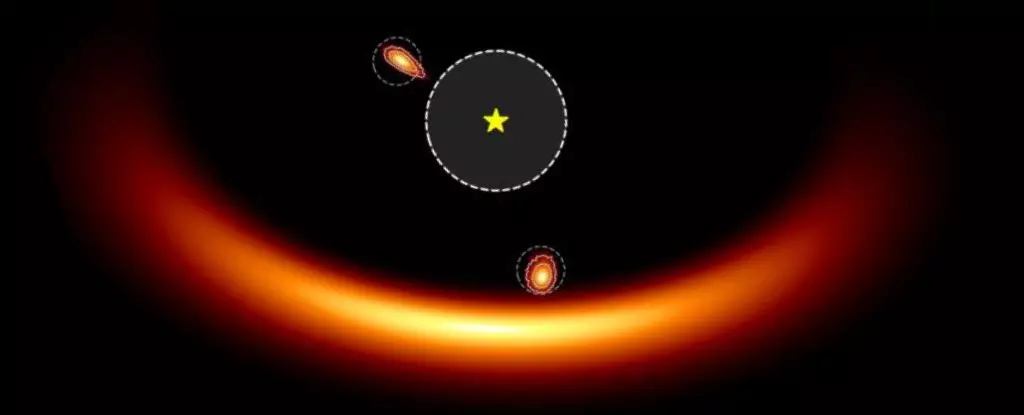The formation of planets remains one of the most captivating processes in astrophysics. Observing this phenomenon directly can yield profound insights into the development of planetary systems. The newly commissioned James Webb Space Telescope (JWST) is revolutionizing our understanding of planet formation, particularly highlighted by its observations of the PDS 70 system. This article delves into the discoveries surrounding PDS 70, its unique planets, and the methodologies employed by astronomers to shed light on what happens during planet formation.
The PDS 70 system, located approximately 370 light-years away, is a majestic example of a young star surrounded by a swirling disk of gas and dust. Within this disk, two young planets—PDS 70b and PDS 70c—are emerging. These planets provide a rare opportunity for astronomers to observe planet formation in real-time, akin to witnessing a cosmic nursery where the building blocks of planets are gathering. Previous direct imaging of these celestial bodies was accomplished by the European Southern Observatory’s Very Large Telescope (VLT) in 2018. Impressively, PDS 70b holds the distinction of being the first confirmed protoplanet ever directly captured in an image.
The advancements made by the JWST are astonishing, as it allows researchers to explore the conditions surrounding nascent planets in unprecedented detail. The methodology employed by the JWST, specifically through the Near Infrared Imager and Slitless Spectrograph (NIRISS), enhances its observational prowess through techniques like Aperture Masking Interferometry (AMI). By utilizing a specially designed mask, JWST can produce a detailed interferogram, effectively increasing its resolution and enabling the examination of features that previously eluded astronomers.
The breakthrough research conducted by Dori Blakely, a graduate student at the University of Victoria, sheds new light on the atmospheres and environments of these young planets. A recent paper published in The Astronomical Journal indicates that JWST’s observations at longer wavelengths reveal critical information about the presence of warm material surrounding PDS 70b and PDS 70c. This material is indicative of a circumplanetary disk, reinforcing the notion that both planets are actively accumulating mass.
Previous observations primarily operating at shorter wavelengths suggested characteristics that aligned more closely with low-mass stars and brown dwarfs. However, the JWST’s deep dive into longer wavelengths unearthed a greater intensity of light emanating from the planets, suggesting that their atmospheric compositions might differ significantly from initial models. This finding is monumental—not only does it enhance our understanding of the specific conditions under which these planets are forming, but it also challenges existing theories regarding their classification.
The implications of these findings are profound. As the co-author Doug Johnstone articulates, “These observations give us an incredible opportunity to witness planet formation as it happens.” Observing these planets in the process of gathering material offers a tangible lens through which we can explore the broader processes that engender planetary systems in the universe. The rarity of such an observation cannot be overstated; it’s akin to watching the early stages of our own Solar System’s development unfold.
The research team has proposed that the competition for material around the PDS 70 star could significantly influence the growth trajectories of the existing planets. PDS 70, a T-Tauri star only 5.4 million years old, is in the early stages of stellar evolution and is still actively accreting material from its surrounding disk. Thus, the dynamic interactions within this system can provide a rich vein of information regarding how future exoplanets—and potentially terrestrial planets—might evolve.
Adding to the intrigue of the PDS 70 system is the potential discovery of a third planet, suggested in previous studies but cloaked in uncertainty. The latest research provides more constraints on this mysterious object, dubbed PDS 70d, yet much remains to be uncovered. If a third planet does exist, evidence implies it could have a markedly different atmospheric makeup from its neighboring planets, PDS 70b and PDS 70c. This diversity raises intriguing questions about planetary formation dynamics and the factors influencing atmospheric development.
The PDS 70 system stands at the forefront of astrophysical exploration and discovery, a testament to the advancements in observational techniques that technology like the JWST affords us. As astronomers piece together this cosmic puzzle, each new finding refines our understanding of the birth and evolution of planets in our universe, bringing us one step closer to comprehending our own Solar System’s origins. The study of planet formation is not merely an academic pursuit; it represents our quest to understand our place within the vast cosmos.


Leave a Reply